People who work in an office spend 8 to 12 hours there. When you spend a third or more of your day sharing a space with dozens of other people, it doesn’t take long for the air quality to decline, especially when one person is harboring cold or flu germs.

Introducing Air Purifiers
Generally, the healthier you are, the happier you are. Air purifiers offer a simple way to improve and maintain healthy indoor air. You simply plug in the air purifier to the nearest electrical outlet, turn it on and the purifier’s fan circulates the room’s air while its filters trap allergens like bacteria, dust and pollen.
Maintaining an air purifier is just as easy as using one. Occasional wipe downs of the exterior and timely filter changes are all that’s needed to keep an air purifier performing at peak efficiency. Many of them have cost-saving washable filters, and some come with remotes or connect to your office’s Wi-Fi network.
Each of the five air purifiers we’ve reviewed is designed for areas of different sizes, so you’re sure to find one that will work for your office. Before you buy, check out our air purifier guide. In this guide, you’ll learn why a true HEPA filter is important, what CADR means and other essential air purifier information.
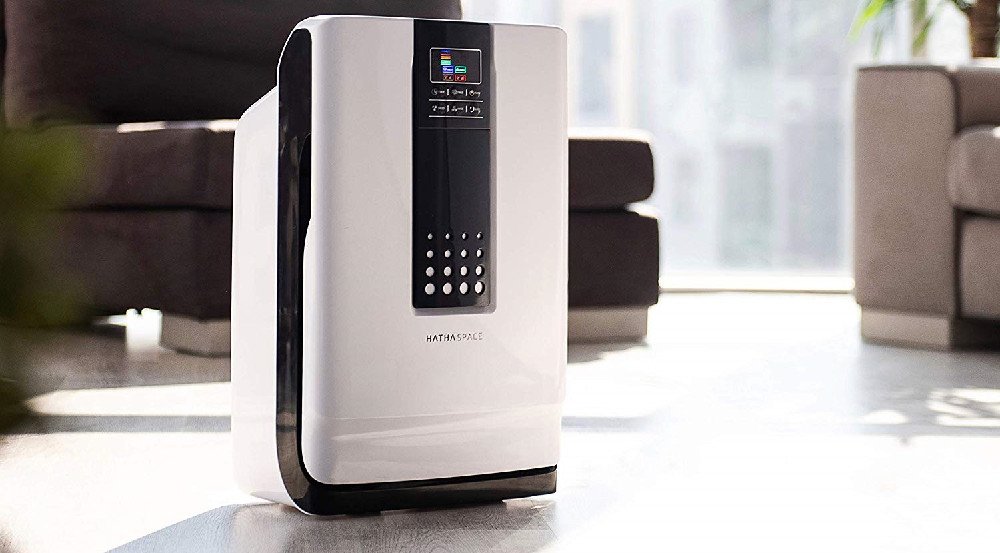
Best Air Purifiers for the Office in 2023
When it comes to air purification, quality counts. After careful review, we chose these five air purifiers based on their large area coverage, efficient filtration media and convenience features.
5) Medify Air MA-40
The Medify Air MA-40-W Air Purifier is equipped with a three-speed fan that circulates air once an hour in a 1,300-square-foot room. A PM2.5 sensor measures the volume of allergens in the air and displays its reading via a color-coded light bar. When set to auto-fan, the MA-40 adjust the fan speed according to the sensor’s air-quality readout.
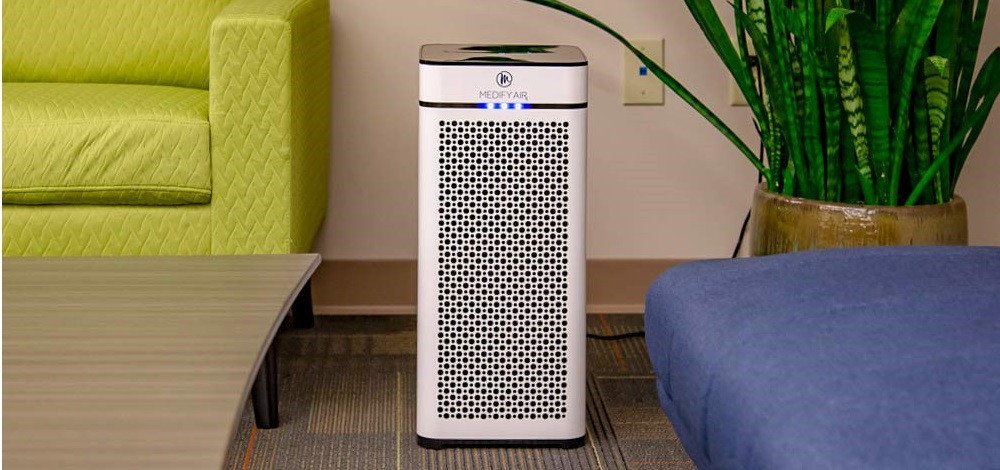
Inside this lifetime-warrantied tower, there’s a true-HEPA filter. The H13 filter traps 99.97 percent of 0.3-micron particles and 99.95 percent of 0.1-micron particles. For capturing larger allergens and odors, the H13 media has a pre-filter and a carbon-pellet layer. An alert light tells you when the easy-to-access filter needs to be changed.
Its CADR rating of 330 indicates the high efficiency level of the MA-40. While the large H13 filter plays a role, the elongated inlet and outlet also contribute to the air purifier’s exceptional airflow. Four corner stabilizers keep the purifier steady, and a recessed handle helps you move the 15-pound unit should the need arise.
On top of the air purifier, a tempered-glass touchscreen gives you access to all the MA-40’s functions. From the scratch-resistant panel, you can set an 8-hour timer, change the fan speed and activate an ionizer. Thanks to a photosensitive sensor, sleep mode will instantly engage when the lights go out, putting the fan on its lowest speed.
- MAXIMUM COVERAGE: Cleans large spaces up to 1,793 sq ft in one hour, 896 sq ft in 30...
- QUALITY TESTED & BACKED: CARB, ETL, and Energy Star certified. Backed by a USA registered...
4) Blueair Classic 480i
This white-and-gray air purifier circulates the air in a 434-square-foot room five times per hour. A 350-CFM fan consumes 15 watts on low speed. It also runs quietly, ranging from 35 to 52 decibels. The two-colored indicator provides information about the current indoor air quality in real-time and sets the fan speed when the Blueair 480i is on auto mode.
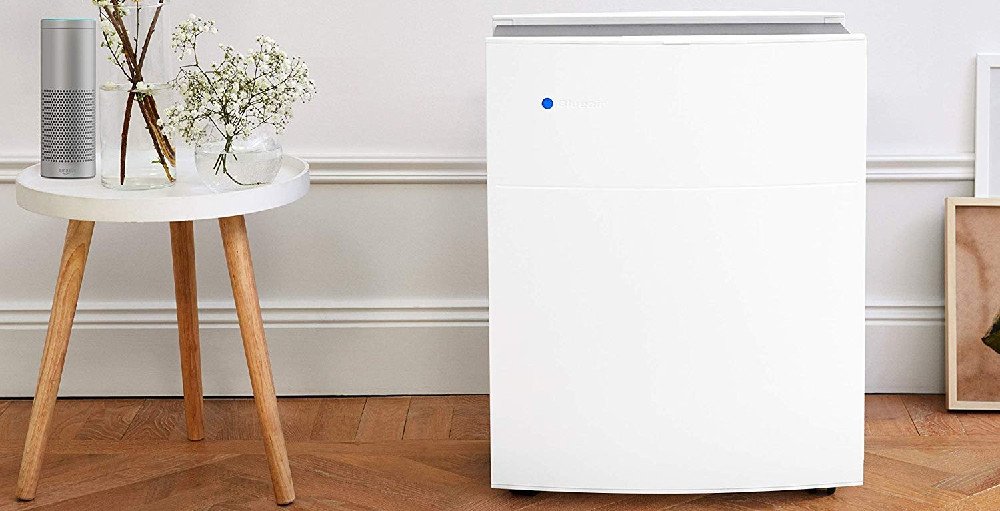
For the Classic 480i, Blueair chose a two-piece filter configuration with an average 6-month lifespan. The cylindrical HEPA filter boasts a large surface area, and the huge cartridge pre-filter has an odor-reducing carbon layer made of coconut shells. Collectively, these filters trap particles as large as 100-micron pollen to those as small as .005-micron viruses.
The Association of Home Appliance Manufacturers gives the 480i clean air delivery rates of 300 CADR for dust and pollen and 280 for smoke. A long vertical inlet and outlet keep the air moving through the air purifier quickly. While the Classic 480i weighs 33 pounds, the tradeoff is a steel housing that stands up to years of use.
Blueair offers three ways to adjust the fan speed, set a timer, and schedule night-mode activation. Touch buttons give you localized control over the 480i. It’s also Wi-Fi enabled so that you can use the Blueair Friend app on your smartphone. You can even pair the purifier with an Alexa device and give the 480i voice commands.
- HEPASilent technology leverages electrostatic charge and mechanical filtration to deliver...
- Dual protection filters with activated coconut carbon, naturally remove gaseous pollutants...
3) Oransi Max HEPA
Oransi’s Max Air Purifier can handle the demands of a 600-square-foot area. It comes with a 10-year manufacturer’s warranty and contains a four-speed fan that circulates at a rate of 330 CFM. The fan is also quiet, ranging from 34 to 53 decibels. In conjunction with a dust-particle sensor, auto-purification mode adjusts the fan speed for you.

The filtration unit lasts approximately 12 months. A felt pre-filter catches large allergens like pollen and hair while a carbon filter adsorbs unpleasant odors. The HEPA filter is rated at MERV 16, which is commonly used in hospital surgical rooms. To enhance their efficiency, the filters are surrounded by a V-seal.
Its ability to filter pollen at a rate of 20, dust at 196 and smoke at 182 puts it right in the middle of the CADR scale. The 18.5-pound Oransi Max measures 17 by 22 inches, but it’s slim in depth at 8 inches and proficiently guides the airflow through one side and out the other.
On the front panel, a simplistic control panel features five chrome push buttons, providing a user-friendly experience. The oversized one turns on the power while the smaller buttons control the anion generator, 12-hour timer, fan speed and auto fan. Also on the control panel are indicator lights for the various modes and filter-change alerts.
No products found.
2) Alen BreatheSmart 75i
On its highest of five speeds, the BreatheSmart 75i changes the room’s air twice at a rate of 350 CFM. Still, Alen’s WhisperMax technology manages to keep the sound at or below 49 decibels and the power consumption at 45 watts. A sensitive particle detector allows for auto-fan adjustment and displays the air quality on a five-color indicator ring.

The lifetime-guaranteed 75i comes with a Heavy Odor filter that targets the most pungent of odors by using 2 pounds of activated carbon. However, you can replace it with a separately purchased filter for general allergens, smoke and VOCs or pet-related particles. Each filter is covered in antimicrobial material and lasts up to 15 months.
A maple-grain front panel gives the BreatheSmart 75i a contemporary elegance, and Alen offers 12 other panels to match any office decor. On the bottom of the 27-pound air purifier, two wheels are affixed to the sturdy stand for easy transport. This purifier also has extremely high CADR ratings – 399 for pollen and 355 for dust and smoke.
Controls come in the form of a sleek touch panel. From this panel, you can cycle through five fan speeds, check the filter life set a 12-hour timer at one of three increments. You can also turn on the ionizer so that the 75i can attack the smallest of particles. All buttons are labeled, effectively eliminating the learning curve.
No products found.
1) Coway Airmega 400S
The Airmega 400S is made for big office spaces of 1,560 square feet. Three fan speeds offer purification customization, and there is even a sleep mode and a smart auto-adjustment mode. Like all other high-quality air purifiers, the 400S is equipped with an air quality indicator, and it relays real-time info via a four-colored double ring.

Energy Star gives the Airmega 400S impressive CADR ratings of 399 for pollen and 328 for smoke and dust filtration. Instead of one filter set, the 400S has two, each of which consists of a pre-filter and true-HEPA Max2 filter with activated carbon. The micromesh pre-filter is washable and lasts throughout the lifetime of the air purifier.
A three-sided intake and sizeable circular outlet maximize the purifier’s air circulation ability. Two integrated handles on the top help you lift and carry the boxy 24.7-pound 400S. Its white finish with graphite gray legs fits into most working environments. A dark-gray version is also available.
There are localized controls for the 8-hour timer and three-speed fan. You can also install the Coway Airmega IoCare app to receive alerts about the filter and the indoor/outdoor air quality as well as control the fan and scheduler. Alternatively, you can teach Alexa Airmega skills for activating smart mode, setting the timer and checking the air quality.
- [Coverage] Designed to clean spaces up to 1,560 sq. ft. in 30 minutes
- [HyperCaptive Filtration System] Combination of a pre-filter, deodorization filter, and...
Buying Guide
Office budgets aren’t without their limits. The working life of the filters is important as the longer they last, the less money you’ll spend on air purifier maintenance. However, the overall efficiency of the air purifier is crucial to the big picture – The more efficient the purifier, the fewer instances of sick-related absences.
True-HEPA filters are more efficient than HEPA-type filters. Ratings like CADR, CFMs, MERV and ACH provide information about an air purifier’s efficiency, and the location/size of the inlet and outlet matter too. Our guide explains the difference between true-HEPA and HEPA-type filters, unpacks the meanings of each rating acronym and tells you about features that offer convenience.
True-HEPA and HEPA-Type Filters
HEPA stands for high efficiency particulate air. A true-HEPA, sometimes referred to as a genuine-HEPA filter, is made of glass or plastic fibers that are woven and secured together with acrylic. In an air purifier, a true-HEPA filter traps 99.97 percent of particles as small as 0.3 microns, including dust, pollen, dander and some bacteria and viruses.
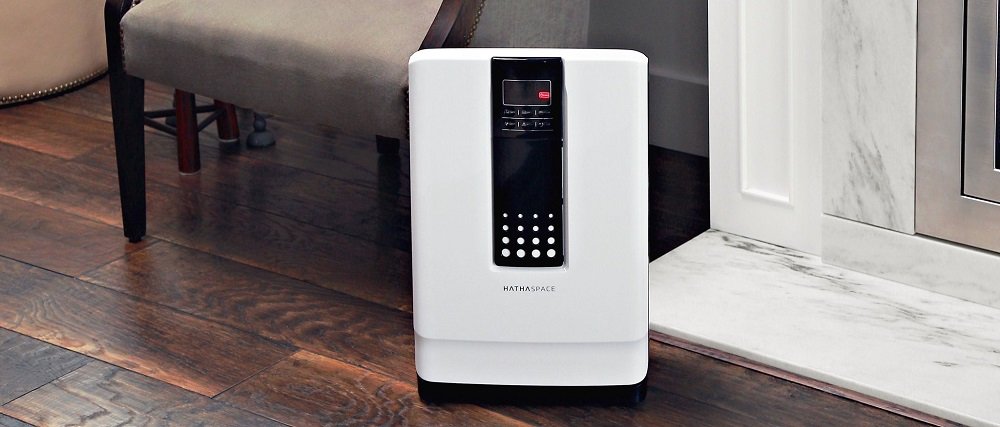
Other filters look just like true-HEPA media. However, they fall short a true-HEPA’s efficiency. Known as HEPA-grade or HEPA-type, these filters vary in terms of the amount and size of particles they can capture. Their efficiency rate usually ranges from 85 to 99 percent, and they may only be able to trap allergens as small as 0.5 microns.
For an office, an air purifier with a true-HEPA filter is a must. If you go with a purifier that uses a HEPA-type filter, there will be many allergens left airborne. In turn, that leads to more illnesses. The cost difference between a true-HEPA and a HEPA-type is minimal, and all high-quality air purifiers use genuine HEPA media.
Efficiency Rating Acronyms
Manufacturers use many acronyms to describe efficiency. ACH stands for air changes per hour. In other words, the speed of air circulation. For instance, an air purifier with an ACH of 4 in 1,000 square feet can circulate all the air four times in 1 hour in that size of a room. The higher the ACH, the better.
CADR, or clean air delivery rate, is an efficiency scale created by the Association of Home Appliance Manufacturers. An air purifier will have three CADR ratings for particles of different sizes – dust, pollen and smoke. Dust and pollen top out at a 450 CADR while a smoke CADR can go as high as 400.
Filters are often rated by their MERV, or minimum efficiency reporting value. Formed by ASHRAE, or the American Society of Heating, Refrigeration and Air Conditioning Engineers, the MERV scale ranges from 1 to 20. For healthy air, the Department of Energy advises the use of a purifier with a MERV 13 or higher filter.
Carbon Filters and Pre-Filters
You shouldn’t rely on a HEPA filter alone to clean the air in your office. Whether it consists of three combined filters, three separate media or a two-part plus a single filter, the air purifier should have a pre-filter, a HEPA filter and an activated carbon filter.
The pre-filter is the media that dirty air moves through first, and it provides an extra layer of protection. Before hair and large particles of pollen and dust can reach the HEPA filter, the pre-filter traps them. As a result, there are fewer contaminants to shorten the HEPA’s working life.
An activated carbon media is used to get rid of displeasing odors such as those that emanate from printer ink or your coworker’s smelly lunch. To make a carbon filter, manufacturers heat treat bamboo, charcoal or coconut shells with steam, causing these substances to form tiny pores that neutralize odors.
Airflow Measurement – CFM
The fan, the inlet and the outlet contribute to the air purifier’s airflow rate. The most efficient air purifiers usually have a direct air path or more than one inlet. As far as the outlet goes, the size matters the most. Whether situated on the side or the top of the air purifier, the outlet should be large.
When you look at the specs of any air purifier, you’ll see the acronym CFM, which means cubic feet per minute. Manufacturers measure the speed of an air purifier’s fan in cubic feet per minute. Most heavy-duty air purifiers contain a variable-speed fan.
The higher the fan speed, the more ACH it can make. AHAM also uses an air purifier’s CFM and an allergen-capturing rate to determine its CADR ratings. For instance, an air purifier with a fan speed of 200 CFM and a true-HEPA filter with a 99.97-percent efficiency will have a CADR of 199.9.
Convenience Features
Streamlining and automating tasks keep the workplace running smoothly. Therefore, you’ll want an air purifier with certain convenience features. You can set a timer to force the air purifier to run only during office hours. Similarly, one with a light sensor will enter low-speed sleep mode when the lights are out. Both functions save energy.
With an LED indicator, you’ll know right away if the air purifier is working as it should and the current health of the office’s air. The inclusion of an indicator means there’s a sensor that will control the fan speed for you, so you can stay focused on work instead of babysitting an appliance.
Some air purifiers are equipped with Wi-Fi connectivity. These purifiers work with the manufacturer’s smartphone app, giving you complete control over the air purifier wherever you are. Others also pair with a virtual assistant such as Alexa, so you can audibly change settings and check the air quality.
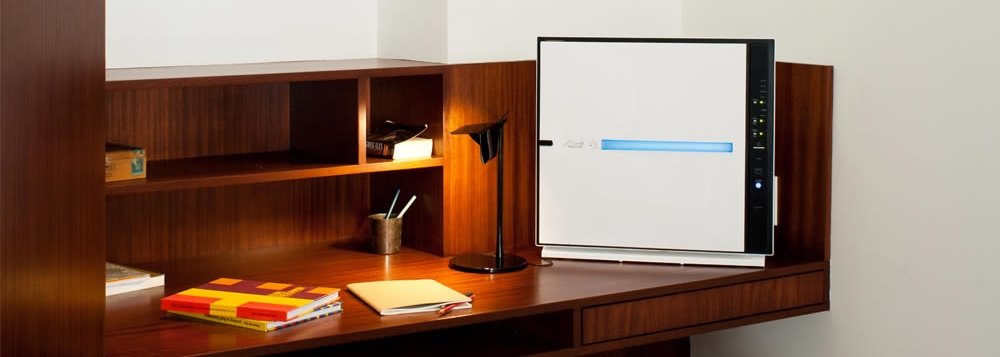
FAQs
What Are Microns?
A micron is a unit of measurement that scientists use to describe the width of a particle. One micron is equivalent to a one-millionth fraction of 1 meter. For perspective, a blood cell in the body is 5-microns wide.
Bacteria are usually 0.3-microns wide. Smoke and dust particles range from about 0.5 to 1 micron while pollen can be as small as 10 microns. Therefore, a true-HEPA filter, especially one with a high MERV value, is always preferable to a HEPA-type filter.
What Is an Ionizer?
Ions are particles with a positive or negative charge. An ionizer, or anion generator, is simply a device that creates ions via electrical current. When built into an air purifier, the ionizer makes and releases ions into the air. Then, the ions attach to airborne particles, allowing the filters to trap allergens smaller than they could collect by themselves.
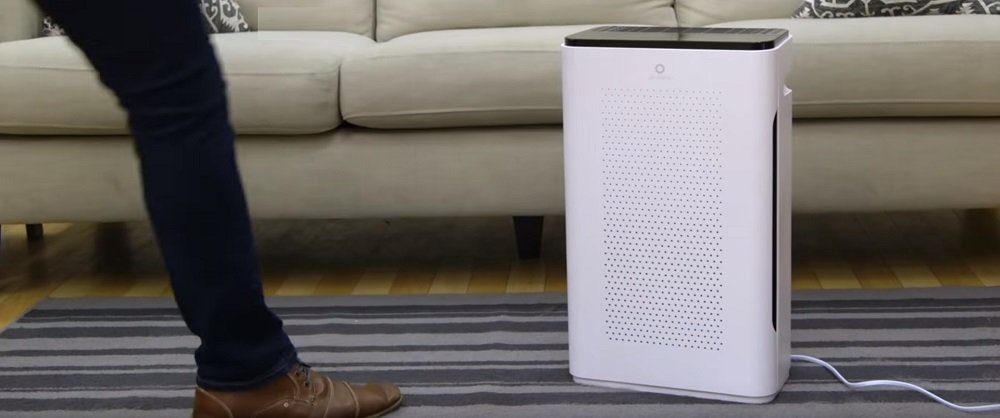
What Are VOCs?
VOCs, or volatile organic compounds, are gaseous chemicals that originate from organic and inorganic materials. Air freshener sprays, paint, copiers, pressed wood and linoleum are just a few common items found in an office that emit VOCs. Many VOCs create odors and can lead to headaches, fatigue and respiratory problems.
Recap
A hygienic office leads to healthier employees and a more productive workplace. Air purifier like the models on our list can help make the environment healthier for everyone. However, some air purifiers are more effective than others. To function as intended, an air purifier must be used within the number of square feet for which it’s rated.
Those with a true-HEPA filter are always recommended over air purifiers that contain a HEPA-style filter. A pre-filter extends the lifespan of the HEPA filter, and an activated carbon filter gets rid of odors and VOCs. If the purifier has an ionizer, it can trap particles smaller than 0.3 microns.
Make sure you check out the various ratings that the manufacturer adds to the specs. The MERV value indicates the precise efficiency of a filter, and the CADR ratings do the same for the overall air purifier. The CFM and ACH describe the speed of airflow and room circulation, respectively.
Consider getting an air purifier with convenience features that will make your workday easier. Whether through a smartphone app or on the purifier, an air quality indicator tells you if the air is healthy or not. An app and voice control let you operate the purifier without leaving your desk, and a timer saves money spent on electricity.
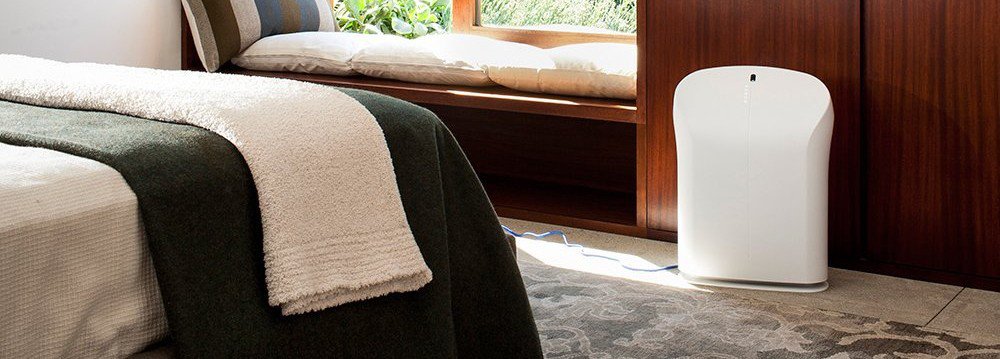
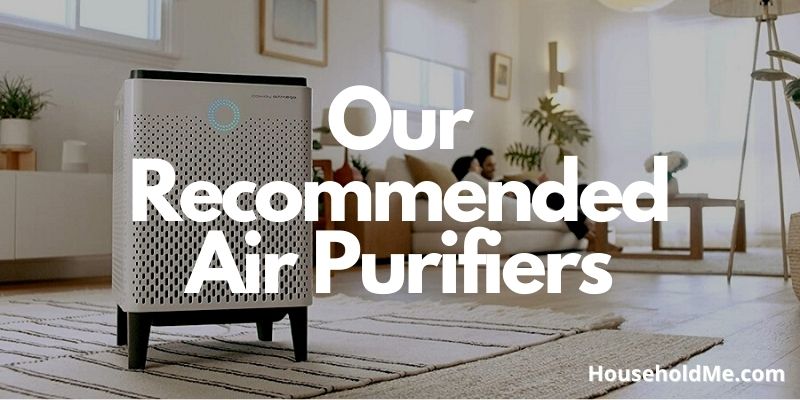
If you have any questions or comments, please add them below in the comment section. Similarly, please let us know if you spot any mistakes or omissions. Thanks!
Last Update: 2024-04-26 | Affiliate links/Images from Amazon Product Advertising API



